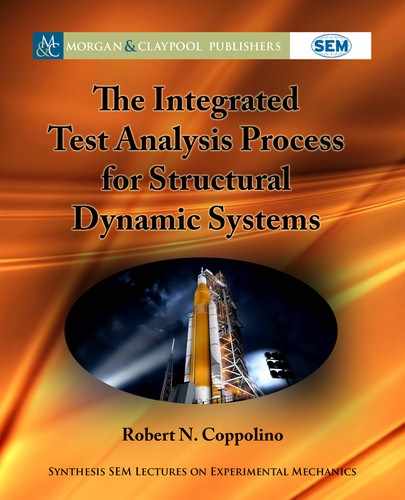6.2. PART 2: CORRELATION OF TEST AND FEM MODES 115
1. Complex mode orthogonality is perfectly satisfied by left-hand eigenvector counterparts
to state-space complex eigenvectors for test and TAM eigenvector sets (Equations (5.19)
and (6.13), respectively).
2. Complex mode cross-orthogonality (correlation) and complex modal coherence are de-
fined based on the complex least-squares process (Equations (6.22) and (6.24), respec-
tively).
Due to (a) the presence of many closely spaced shell breathing modes of the test article
and (b) non-proportional damping (which is a basic reality of all built-up structural dynamic
systems), the test article’s modes are generally complex (and are not readily approximated as
“real” modes).
6.2.5 ILLUSTRATIVE EXAMPLE: ISPE MODAL TEST
e ISPE TAM model is described 75 real, undamped modes in the 0–65 Hz frequency band
computed from the reduced TAM model (expressed in state-space form according to Equa-
tions (6.15)–(6.18)). ISPE modal test data consists of 63 complex modes in the 0–65 Hz fre-
quency band, estimated by the SFD-2018 algorithm. Following the “recipe” based on Equa-
tions (6.13), (6.22), and (6.24), complex mode orthogonality, cross-orthogonality, and modal
coherence matrices are summarized in Figure 6.2.
e TAM and test mode orthogonality matrices are perfect identity matrices. e cross-
orthogonality matrix appears similar in form to its state-space counterpart (see Figure 6.1), and
the modal coherence matrix indicates that the majority of lower frequency (
50%) of test modes
are strong linear combinations of the TAM modes.
Recalling the fact, introduced in Chapter 3, that the orthogonality matrix can be “un-
packed” to describe a subject system’s modal kinetic energy distribution (Equation (3.3)), a corre-
sponding “unpacking” of the complex state-space mode orthogonality matrix (Equation (6.13))
similarly describes the kinetic energy distribution of the complex modes.
In particular, the modal orthogonality and kinetic energy distribution relationship pair for
a complex state-space modal set is defined, in terms of left- and right-hand eigenvectors as,
Œ
OR
D
Œ
ˆ
L
Œ
ˆ
D
Œ
ˆ
V;L
Œ
ˆ
V
C
Œ
ˆ
U;L
Œ
ˆ
U
;
Œ
KE
ˆ
D conj
ˆ
L
˝
Œ
ˆ
D conj
ˆ
V;L
˝
Œ
ˆ
V
C conj
ˆ
U;L
˝
Œ
ˆ
U
:
(6.25)
Note that Œˆ
in the present context corresponds to the complex conjugate transpose
of the matrix, Œˆ; the same operator designation applies to the left-hand eigenvector matrix.
Partitioning of the complex state-space left- and right-hand eigenvectors into “velocity” and
“displacement” partitions (designated by the subscripts “V ” and “U ”, respectively), in order to
describe the modal kinetic energy distributions in terms of the measured DOFs, the above defi-
nitions of complex state-space eigenvector orthogonality and modal kinetic energy distributions
are independent of the TAM mass matrix.
..................Content has been hidden....................
You can't read the all page of ebook, please click here login for view all page.
